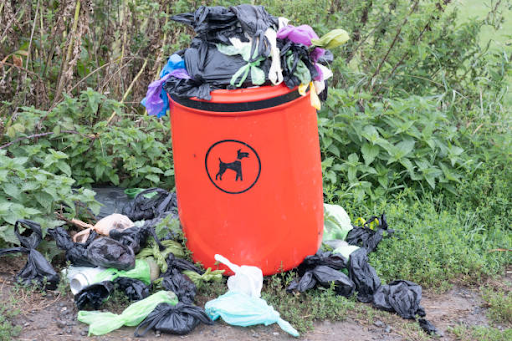As responsible pet owners, it is crucial to address the issue of unmanaged dog waste in our communities. Not only does it pose health hazards to humans and pets, but it also contributes to environmental pollution. According to recent studies, an average dog produces approximately 274 pounds of waste per year, adding up to millions of tons of waste nationwide. This staggering amount emphasizes the need for proper waste disposal solutions. In this article, we will explore the benefits of pet waste stations, their components, installation considerations, and how they aid in dog waste management. Join us in understanding why these stations are essential for maintaining clean and healthy environments for both our furry friends and ourselves.
The Problem: Unmanaged Dog Waste
Unmanaged dog waste poses significant challenges that need to be addressed promptly. Firstly, it creates health hazards for both humans and pets. The waste contains harmful bacteria and parasites that can spread diseases. Secondly, the environmental impact cannot be overlooked. When dog waste is left unattended, it pollutes our water sources and soil, affecting the ecosystem. Additionally, unmanaged dog waste creates community issues and conflicts. The presence of dog waste in public areas is unsightly and can lead to tensions among community members. To ensure a cleaner and healthier environment, it is crucial to tackle the problem of unmanaged dog waste through proper waste management strategies.

Benefits of Pet Waste Stations
Pet waste stations offer numerous advantages in addressing the pinpoints associated with dog waste management. These stations provide a convenient and responsible solution for pet owners to dispose of their dog's waste properly. By encouraging pet owners to pick up after their dogs, these stations reduce health risks, especially from harmful bacteria and parasites present in the waste. Moreover, they play a vital role in preserving the environment by preventing the contamination of water sources and reducing pollution. Pet waste stations also promote good community relations by ensuring cleaner public spaces and reducing conflicts among neighbors. Overall, these stations are an essential tool in maintaining a healthy and hygienic environment for everyone.
Reduction of health risks
Pet waste stations play a crucial role in addressing the pinpoints related to health risks associated with dog waste. These stations promote responsible pet ownership by providing a convenient and accessible solution for waste disposal. By encouraging pet owners to promptly clean up after their dogs, the risk of harmful bacteria and parasites spreading is significantly reduced. This helps protect both humans and pets from potential infections and illnesses. Implementing pet waste stations ensures a cleaner environment, minimizing the chances of accidental contact with waste. By prioritizing health and hygiene, these stations contribute to creating safer and healthier communities for everyone to enjoy.
Promotion of good community relations
Pet waste stations play a crucial role in addressing the pinpoints related to dog waste management and actively contribute to fostering good community relations. By providing a convenient and accessible solution for pet owners to dispose of their dog's waste, these stations ensure cleaner public spaces and reduce unpleasant odors. This, in turn, promotes a harmonious living environment and minimizes conflicts among neighbors. Additionally, pet waste stations demonstrate a shared commitment to maintaining a clean and hygienic community, which enhances the overall quality of life. Encouraging responsible pet ownership through these stations strengthens the bond between community members and creates a sense of pride in the neighborhood.

Cost and Maintenance of Pet Waste Stations
When it comes to implementing pet waste stations, cost and maintenance are important considerations. We understand the concerns surrounding expenses, but let us assure you that the long-term benefits outweigh the initial investment. By installing pet waste stations, you're proactively addressing the health hazards and environmental issues caused by unmanaged dog waste.
Cost-Effective Solutions: We offer a range of affordable options that cater to different budgets. Our waste stations are designed to be durable and low-maintenance, reducing future expenses. Additionally, we provide cost-effective alternatives such as community sponsorship programs and partnerships to share the financial responsibility.
Maintenance Tips: We understand the importance of keeping the stations clean and functional. Regular cleaning and waste removal help maintain a pleasant environment. We provide clear instructions and guidelines to ensure proper maintenance. By following these simple steps, you can ensure the effectiveness and longevity of your pet waste stations.
Investing in pet waste stations is an investment in your community's health and cleanliness. Let us help you find the best solution that fits your budget and addresses the concerns surrounding cost and maintenance. Together, we can create a cleaner and healthier environment for all.
Conclusion
In conclusion, pet waste stations are a crucial aspect of effective dog waste management. By addressing the pinpoints of unmanaged dog waste, these stations provide a convenient and responsible solution for pet owners. The benefits of implementing pet waste stations are numerous, including reducing health risks for both humans and pets, preserving the environment, and promoting good community relations.
To ensure the success of pet waste stations, proper installation and placement considerations must be taken into account. Collaboration with local authorities or property management can help identify ideal locations for these stations. Additionally, educating pet owners about the importance of waste management and fostering a sense of responsibility and accountability are essential in creating a cleaner and healthier community.
Implementing pet waste stations may require an initial investment, but the long-term benefits far outweigh the costs. By sharing success stories and case studies, we can inspire other communities to take action and improve dog waste management. Overcoming challenges and objections, such as addressing concerns about cost and implementing effective strategies, will contribute to the success of these initiatives.
Frequently Asked Questions (FAQ)
A.Pet waste stations typically provide waste bags and a trash can for pet owners to dispose of their pet's waste. They are installed in public areas where pet owners frequently walk their dogs.
A.Pet waste stations are affordable and can be purchased or rented by property owners, municipalities, or parks departments.
A.Pet waste stations should be emptied regularly to prevent overflow and maintain cleanliness. The frequency of emptying depends on the usage and location of the pet waste station.
A.Pet waste should not be composted in home compost piles as it can contain harmful bacteria and parasites. However, there are commercial composting facilities that can handle pet waste.
A.Pet waste stations are designed to be used for dog waste management, but they can also be used for other pets, such as cats. It is important to check the specifications of the pet waste station to ensure it can accommodate the waste of different types of pets.



